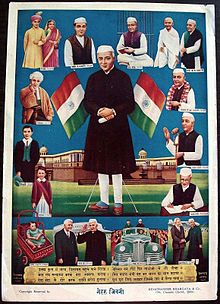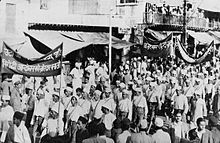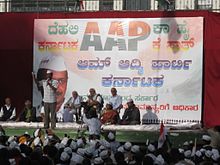Gandhi cap

TheGandhi cap(Hindi:गाँधी टोपी) is a whitesidecap,pointed in front and back and having a wide band. It is made out ofkhadi.It takes its name after the Indian leaderMahatma Gandhi,who created it and first popularised its use during theIndian independence movement.
Worn commonly byIndian independence activists,it became a symbolic tradition for politicians and political activists to wear in independent India.
Genesis[edit]

Gandhi, in a conversation withKaka Kalelkar,described how he created theGandhi cap.Gandhi said that he looked at a number of caps from various parts of India and wanted to design a cap that would cover the head in hot weather and would be easy to keep in a pocket. He found Kashmiri cap to be coming close to what he wanted to design but it used wool. Gandhi writes that he instead used cotton cloth in white because white clothes are supposed to be washed more regularly and are easier to wash.[1]
The Gandhi cap emerged in India during theNon-cooperation movementfrom1920to1922,[2]when it became the standard Indian National Congress dress as popularized by Gandhi.
By 1920, a substantial number of Indian males wore this cap. Colonial officials in theCentral ProvincesbannedIndian Civil Serviceemployees from wearing Gandhi caps.[3]
Gandhi's homespunkhadiattire of traditional Indian clothes were symbolic of his message of cultural pride, the use ofSwadeshigoods (as opposed to those manufactured in Europe), self-reliance and solidarity with India's rural masses. The cap became common to most followers of Gandhi and members of theIndian National Congress.A connection to the independence movement was implied when any individual wore the cap in those times.
Black prisoners in South African prisons were required to wear a small headcover during the early 20th century. This has been cited as the genesis of the Gandhi Cap.[4][5][6]

The Gandhi cap was also adopted by the members ofRashtriya Swayamsevak Sangh(RSS).
After independence[edit]
The first generation of post-independence Indian politicians were almost universally members of the freedom struggle. The cap was regularly worn by Indian leaders likeJawaharlal Nehru,India's firstPrime Ministerand the succeeding prime ministers such asLal Bahadur ShastriandMorarji Desaicontinued this tradition. Most members of theIndian Parliament(especially politicians and activists of the Congress party) worekhadiclothing and theGandhi cap.Large numbers of people donned the cap while celebrating India's independence on August 15 or the promulgation of arepublicon January 26.
Jawarharlal Nehru was always remembered as having worn the cap. In 1964 a coin showing Nehru in profile was released which was widely criticized for lacking the cap. Another Nehru coin was later released in 1989 on his birth centenary, which showed him wearing a cap.
In later times, the cap had lost its popular and political appeal. Although many members of the Congress party continued the tradition, rival political parties preferred to dissociate themselves from the tradition linked with the Congress. The mass acceptance of Western-style clothing had also diminished the importance of wearing Indian-style clothes for politicians.

The cap remains the most popular everyday headgear worn by men in rural parts ofMaharashtra.[7]

In the "I Have a Dream"speech ofMartin Luther King Jr.in 1963, many people standing behind him on stage wore Gandhi caps.[8]
Re-emergence[edit]
In 2011, the Gandhi cap once again rose in popularity in India afterAnna Hazare,an eminent Gandhian fromMaharashtra,started an anti-corruption movement in India. The epicenter of this movement was in Delhi. In August 2011, thousands of people wearing Gandhi caps accumulated atRamlila Maidanin Delhi to support Anna Hazare on hisfast-unto-death.This movement spilled over to many other parts of the country and stadiums, community centers and grounds were booked for assimilation of a similar nature. The mass movement included people of all age groups, religions and social standings (mainly themiddle class) as participants, many among them shouting slogans and wearing Gandhi caps.
In the 2014 election, the workers ofAam Aadmi Partywidely wore the Gandhi cap with text printed on it.[9][10]
Supporters of theBharatiya Janata Partyalso wear the Gandhi cap but insaffroninstead of white.[11]

See also[edit]
- Cap of Maintenance
- Dutch cap
- Indian National Congress
- Pagri (turban)
- Peshawari pagri
- Side cap
- Songkok
- Taqiyah
References[edit]
- ^Clothing Matters: Dress and Identity in India, Emma Tarlo, University of Chicago Press, Sep 1, 1996.82-83[1]
- ^Consumption: The history and regional development of consumption edited by Daniel Miller, p. 424
- ^Tarlo, E. (1996).Clothing Matters: Dress and Identity in India.Hurst. p. 84.ISBN978-1-85065-176-5.
- ^Paul John (9 January 2014)."Gandhi sewed caps in South Africa prison".Times of India.Retrieved6 February2023.
- ^H.S.L PolakMahatma Gandhi(London: Odham's Press, 1949) pg. 61
- ^Uppal, J.N. (1995).Gandhi Ordained in South Africa.Publications Division Ministry of Information & Broadcasting. p. 348.ISBN978-81-230-2212-3.Retrieved2022-06-22.
- ^Bhanu, B.V (2004).People of India: Maharashtra, Part 2.Mumbai: Popular Prakashan. pp. 1033, 1037, 1039.ISBN81-7991-101-2.
- ^Tharoor, Kanishk (2018-04-04)."The Debt MLK Owed to India's Anti-Colonial Fight".The Atlantic.Retrieved2020-02-13.
- ^"बहुरंगी हुई गांधी की टोपी".jagran.Retrieved8 April2018.
- ^Whitehead, Andrew (28 April 2014)."How India's iconic Gandhi cap has changed sides".Retrieved8 April2018– via bbc.
- ^Bhattacharjee, Sumit (24 April 2014)."Gandhi cap changes colours!".Retrieved8 April2018– via thehindu.
